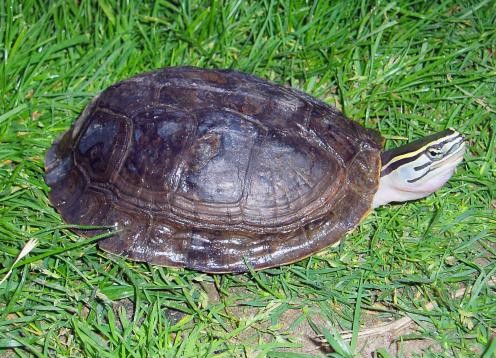Type the name of the breed you're looking for below
[wpdreams_ajaxsearchlite] Don't see the breed your're looking for? Click here and let us know!
Malayan Box Turtle
| Place of Origin and Range | Wild collected and imported from Malaya. |
| Description | These turtles have blackish-brown to olive brown coloured shells that are not as ornate as many other box turtles. All have a blackish olive head with three yellow stripes on the side. The male can be identified by the slightly concave shape to its plastron. There is no specific pattern to what the underbellies may look like, for either sex. The only true way of telling age is to guess by the texture of the shell, as growth rings form irregularly. |
| Morph Patterns Available | Yes |
| Adult Size | Can grow up to 8in(20cm) |
| Accommodation | It is found in a wide variety of habitats, including floodplain swamps, marshes, seasonal wetlands, and permanent ponds. A filtered semi-aquatic cage with water temperature at 70-80'F(21-26'C), and a sloping ramp(driftwood, textured plastic or some other non-abrasive surface) leading from the bottom to an illuminated and warmed basking spot. Approx 80'F(27'C). 2 x 4 feet for an adult. |
| Lifespan | Can live 20+ years |
| Feeding / Diet | There are a variety of foods which are universally accepted by eastern box turtles, which include earthworms, snails, slugs, grubs, beetles, caterpillars, grasses, fallen fruit, berries, mushrooms, flowers, bread, duck weed, and carrion. |
| Other Considerations | Watch for theses health concerns carefully with your turtle. Vitamin A Deficiency: Vitamin A is an important nutrient for your turtle’s health. It is found in his diet in the form of leafy green, orange or yellow vegetables, liver, and fish. If your turtle is not getting enough Vitamin A, he can suffer serious health problems. Always check to make sure that your turtle does not have swollen eyelids, as this is the main sign of a Vitamin A deficiency. Also, check for weight loss, nasal discharge and infected skin. Any of these symptoms could point to a deficiency. If you think your turtle may not be getting enough Vitamin A, you should take him to the veterinarian to get a firm diagnosis. Shell Problems: Your turtle’s shell is very important to his overall health. There are many potential problems that could occur, so you should be on the lookout at all times. Respiratory Disease: Respiratory infections have symptoms similar to vitamin A deficiency, including swollen eyelids and runny nose, so you should take your turtle to the veterinarian to get a proper diagnosis if you suspect either. More serious infections will be characterized by breathing through the mouth, mucus in the mouth, and wheezing. Always make sure your turtle’s environment has the proper amount of humidity, as this will help prevent respiratory problems. |



